
ITR 6 Form is to be furnished by the Companies to e-file the income tax returns if they are not claiming exemption under Section 11 of the Income Tax Act 1961. Under the Income-tax Rules, the Companies that can claim an exemption under section 11 are those that have income from the property that is held for the charitable or religious person.Hence, ITR 6 is to be filed by the companies that do not claim an exemption under section 11.
If in case the assessee is liable for the audit u/s 44AB and the accountant has audited the accounts, then the details of the audit report, the auditor along with the date of furnishing is to be sent to the department electronically.
Companies who have sources of income from religious or charitable organizations can seek exemption under Section 11. In simpler words, an entity that is seeking exemption under Section 11 should not file ITR 6 Form.
ITR 6 is divided into Part A and Part B ( along with the subsections) with multiple schedules that include information relevant to the income and tax of the taxpayer. Let us have a detailed look at this.
General information: This Subsection should be filled with the basic details of the entity such as the Name, PAN number, address, CIN, Incorporation date, etc
Trading Account: This subsection requires the details that are relevant to the income and expenditure of the company.
Balance sheet: This subsection should consist of the details of the balance sheet of the company such as the liabilities, current liabilities, share capital, and more.
Manufacturing account: This Subsection required the figures of manufacturing the accounts relating to the inventory such as opening stock, closing stock, and cost of the goods that are produced.
Profit and Loss Account: This subsection should be filed with the details of the company’s profit or the loss that is incurred during the relevant financial year.
Part B-TI: Computation of Total Income
Part B-TTI: Computation of Tax liability of the Total Income.
©2022. Trace Quality . All Rights Reserved.